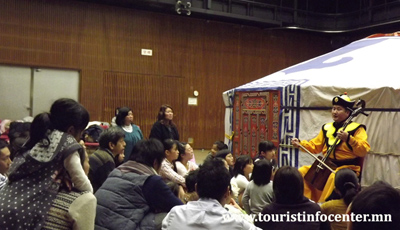Морин хуур
 Монголчуудын түүхийг морь бүтээсэн гэж зүй
ёсоор хэлж болно. Монголчууд хүнээсээ олон морь дагуулан явж дайтдаг байв. 3
өдрийн дараа ирнэ гэж тооцоолж байтал 1 өдрийн дараа л ороод ирдэг морьт
армитай байв. Монголчууд хамгийн эрхэмлэн хайрладаг мориндоо зориулан хөгжмийн
зэмсэг бүтээсэн билээ. Товшуур, эхил, цоор, хулсан хуур, морин хуур нь нэн эртний
чавхдаст
монгол хөгжим юм.
Монголчуудын түүхийг морь бүтээсэн гэж зүй
ёсоор хэлж болно. Монголчууд хүнээсээ олон морь дагуулан явж дайтдаг байв. 3
өдрийн дараа ирнэ гэж тооцоолж байтал 1 өдрийн дараа л ороод ирдэг морьт
армитай байв. Монголчууд хамгийн эрхэмлэн хайрладаг мориндоо зориулан хөгжмийн
зэмсэг бүтээсэн билээ. Товшуур, эхил, цоор, хулсан хуур, морин хуур нь нэн эртний
чавхдаст
монгол хөгжим юм.The Morin Khuur is the most widespread instrument in Mongolia, and is played during celebrations, rituals and many other occasions, as well as an accompaniment for dances or songs. Today Mongolians and Mongolian government is paying special attention to development and deepening interest of people in Morin Khuur. An example of this is 999 horse-head fiddle players who performed during Naadam. Also horse-head fiddle players’ assembly is now about in its 20th anniversary. This assembly consists of the best Morin khuur players and plays all around the world promoting this traditional instrument to Europeans as well as Asians.
The horse and the fiddle have played a very important role in the life of the nomadic Mongolian animal herding culture. Much of the oral history and literature of the Mongolian people contain stories about horses and the horse-head fiddle instrument. From ancient times the Mongolian people have used the horse for transportation and have given it an honored position in their everyday lives. For example, when a horse died, its head was placed on top of a mountain, rather than buried in the dirty ground. The horse's tail was carefully preserved to make strings for musical instruments, and the soft skin of the horses groin was used to cover the body of the “horse-head fiddle” instrument.
The horse-head fiddle is evident in sources dating from the 13th century during the Mongol empire. It was thought that the first bowed instruments came from the nomads of central Asia. The Scythian Harp found in 5th Century BC grave in the Altai Mountains being evidence pointing to this. In Chinggis Khaan’s era the Morin khuur was used to open important state ceremonies and is now the National Instrument of Mongolia.
There are many legends about the origin of the Morin Khuur. One of them was said that the Morin Khuur was born as a result of the caress that a man gave to his dead steed. Its wings had been cut off by the rider’s sweetheart in order to prevent him from going away. The man who was inconsolable and obsessed by the memory of his dead companion set about carving the head of the horse out of a long piece of wood which was then put into a vessel after having been covered with horse hide. Then he made two strings and a bow out of the horse’s hair from its tail and he made use of the instrument in order to praise the exceptional qualities of his dead horse thus allaying his grief.
The instrument consists of a trapezoid wooden-framed sound box to which two strings are attached. It is held nearly upright with the sound box in the musician’s lap or between the musician’s legs. The strings are made from the tail of a horse and run from the end of the spike at the base, over the wooden bridge on the body, over the nut and through the neck to the tuning pegs or ears. The strings are called thick and thin and also male and female. The thinner string should have about 105 hairs from the mare's tail while the thicker 130 from the stallions tail. These strings are now tuned a fourth apart, but used to be tuned a fifth apart. The traditional wooden framed sound box used to be covered on the front with baby camel, goat or sheep skin with a circular sound hole at the back on the belly. Nowadays the workshop produced ones have a wooden face with “F holes” similar to European stringed instruments.
The fiddle’s significance extends
beyond its function as musical instrument and it is a traditionally integral
part of rituals and everyday activities of the Mongolian nomads. Playing the Morin
khuur is accompanied with dances, long songs, mythical tales, ceremonies and
everyday tasks related to horses. The Morin khuur also accompanies Biyelgee,
the body dance of hand, shoulder and legs movement. This dance originated in
the Altai mountains in the west of Mongolia.
